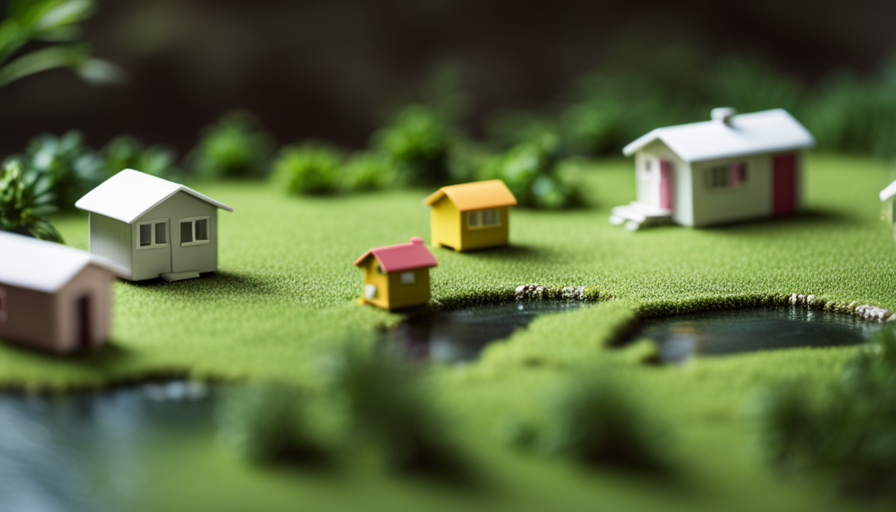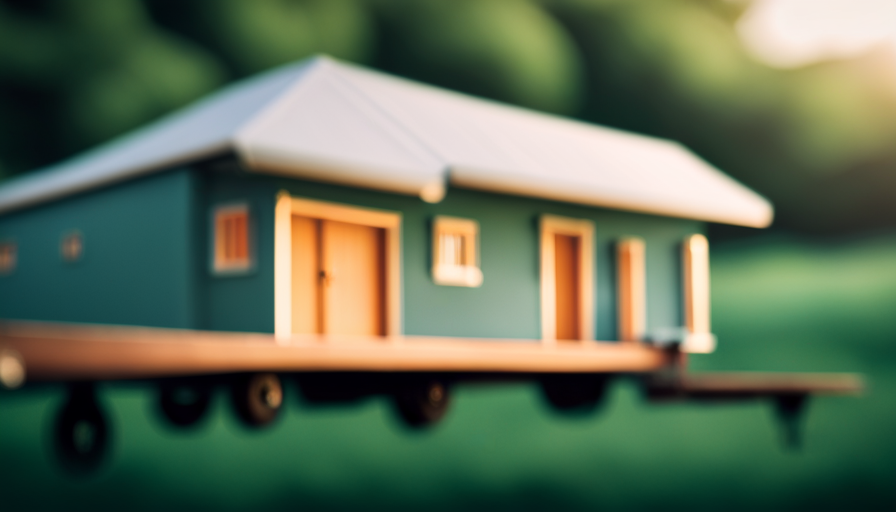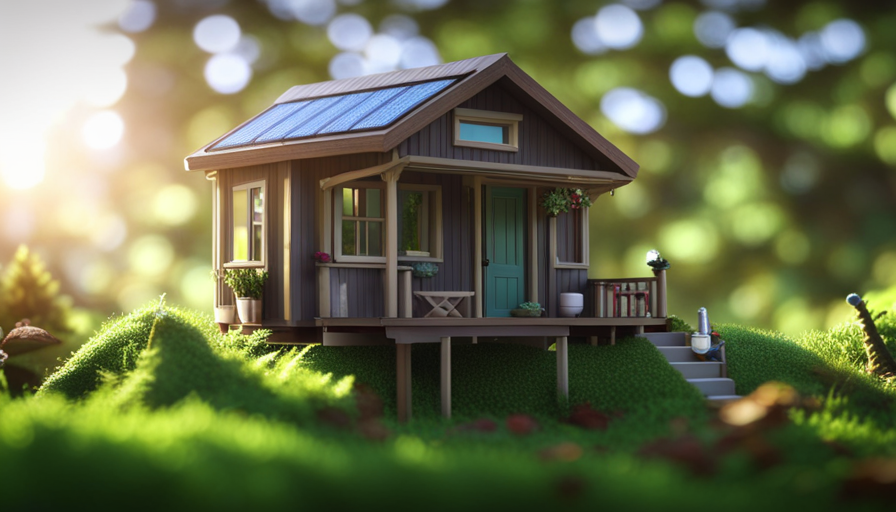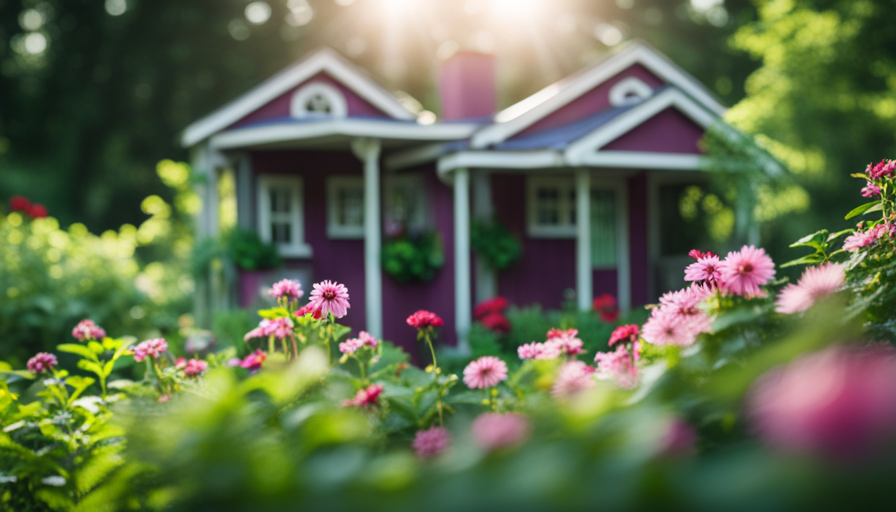Are you ready to embark on the exciting journey of building a tiny home? Get ready to be impressed by the incredible potential of a small space that packs a big punch! Stay tuned, as in this article, I will uncover the surprising truth behind the cost of constructing a tiny house.
Now, you may be wondering, how much will this extraordinary endeavor set you back? Well, hold onto your hats, because the answer may surprise you! Building a tiny house is not only an economical decision but also an opportunity to unleash your creativity and embrace a minimalist lifestyle.
In this detailed and informative article, I will guide you through the process of determining your budget, researching materials and labor costs, considering the size and design, and even exploring financing options. We will delve into the nitty-gritty, analyzing every aspect from permit fees to unexpected expenses.
So, put on your construction hat and get ready to dive headfirst into the world of tiny house building, where dreams become reality and the possibilities are truly endless!
Key Takeaways
- Building a tiny house is an economical decision that offers the opportunity for a minimalist lifestyle.
- Researching and comparing costs of materials and labor is essential for staying within budget.
- Design elements and custom features may increase expenses, so careful consideration is necessary.
- Planning for utilities and off-grid options, as well as budgeting for furniture and appliances, are important aspects to consider when building a tiny house.
Determine Your Budget and Priorities
To figure out how much I can spend on building my tiny house, I’ll need to prioritize my budget and make some decisions. Determining priorities is essential in order to allocate funds effectively. I need to consider what features are most important to me and what I can compromise on.
For example, if I prioritize energy efficiency, I may need to invest more in insulation and solar panels. On the other hand, if I value a spacious kitchen, I may need to allocate more funds towards appliances and cabinetry.
Setting financial goals is another crucial aspect of determining my budget. I need to assess my current financial situation and establish a clear target for how much I’m willing to spend on my tiny house. This will help me stay on track and avoid overspending. I may need to make some sacrifices and cut back on unnecessary expenses to save enough money for my project.
Once I have determined my priorities and set my financial goals, I can move on to the next step of my tiny house journey. In the subsequent section, I’ll research and compare costs of materials and labor, ensuring that I make informed decisions and get the best value for my money.
Research and Compare Costs of Materials and Labor
You’ll find comparing the prices of materials and labor for building a tiny house to be an essential step in your research. When it comes to building a tiny house, one of the key factors to consider is the cost.
To ensure that you stay within your budget, it’s important to research and compare the costs of materials and labor. There are several cost-saving strategies that you can employ to keep expenses down. For example, consider using alternative building materials such as reclaimed wood or recycled materials. These options can be more affordable and also contribute to a sustainable lifestyle.
Additionally, researching and comparing the prices of different suppliers and contractors can help you find the best deals. It’s important to obtain multiple quotes and ask for references to ensure that you’re getting the best value for your money. By taking the time to research and compare costs, you can make informed decisions and potentially save a significant amount of money.
With these cost-saving strategies and careful consideration of materials and labor, you can build your tiny house without breaking the bank. As you move on to the next section about considering the size and design of your tiny house, keep in mind the financial implications of these choices.
Consider the Size and Design of Your Tiny House
Considering the size and design of your tiny house can greatly impact the overall functionality and livability of the space. Before diving into the construction process, it’s crucial to carefully evaluate the cost considerations and limitations associated with the size and design you have in mind.
One of the most significant factors to consider is the cost. Generally, the larger the tiny house, the more materials and labor will be required, which can significantly drive up the overall cost. Additionally, unique design elements or custom features may also contribute to higher expenses. It’s essential to strike a balance between the desired size and design and the budget you have allocated for the project.
Moreover, size limitations should not be overlooked. Depending on local regulations and zoning restrictions, there may be specific size limitations for tiny houses. Understanding these limitations before starting the design phase can save you time, money, and potential legal complications down the road.
As you consider the size and design of your tiny house, it’s crucial to keep in mind the cost considerations and size limitations. Understanding these factors will help you make informed decisions about the overall design, ensuring that your tiny house is both functional and within your budget. Moving forward, it’s important to factor in permit and inspection fees to ensure a smooth and compliant construction process.
Factor in Permit and Inspection Fees
Including permit and inspection fees in your budget ensures a smooth construction process as you navigate the necessary legal requirements for building your dream tiny house. The permit application process varies depending on your location, so it’s important to research and understand the specific requirements in your area. Typically, you will need to submit detailed plans and specifications for your tiny house, along with an application fee. Some jurisdictions may also require additional documents, such as proof of ownership or a zoning compliance letter. It’s crucial to factor in the cost of these permits when estimating the overall cost of your tiny house project.
Once you have obtained the necessary permits, you will need to schedule inspections throughout the construction process. These inspections ensure that your tiny house meets the required safety and building codes. Common inspection requirements include checking the foundation, electrical wiring, plumbing, and overall structural integrity. You may need to pay inspection fees for each visit, so it’s essential to include these costs in your budget.
To give you a better idea of the potential fees involved, here is a sample table outlining the permit and inspection costs for a hypothetical tiny house project:
| Permit Type | Cost |
|---|---|
| Building Permit | $500 |
| Electrical Permit | $200 |
| Plumbing Permit | $150 |
| Zoning Compliance Letter | $100 |
| Inspection Fees (average) | $300 per visit |
By considering these permit and inspection fees, you can better plan and budget for your tiny house construction. In the next section, we will discuss the importance of planning for utilities and off-grid options.
Plan for Utilities and Off-Grid Options
When it comes to planning for utilities and off-grid options, you can envision a cozy and self-sufficient lifestyle in your dream tiny house. One of the main considerations is the off-grid power options. In order to live off the grid, you’ll need to invest in alternative power sources such as solar panels or wind turbines. These options can provide you with a reliable and sustainable source of electricity, reducing your dependence on traditional power grids.
Water and waste management are also crucial aspects to plan for when building a tiny house. Depending on your location and local regulations, you may need to install a well or a rainwater harvesting system to ensure a steady supply of water. Additionally, implementing efficient water-saving fixtures can help minimize water consumption. As for waste management, composting toilets are a popular choice among tiny house owners as they’re environmentally friendly and require no water.
Transitioning into the subsequent section about budgeting for furniture and appliances, it’s important to consider the cost of outfitting your tiny house with the necessary items to make it feel like a home. From compact furniture to energy-efficient appliances, these additions can greatly enhance your living experience in the tiny house.
Budget for Furniture and Appliances
To truly transform your tiny oasis into a personalized sanctuary, envision yourself curled up on a cozy sofa, sipping a warm cup of coffee brewed effortlessly from your compact yet efficient appliance collection. When budgeting for furniture and appliances in your tiny house, it’s essential to consider cost-effective options that maximize space without sacrificing comfort.
Here are three items to consider:
-
Multi-purpose furniture: Look for pieces that serve multiple functions, such as a sofa that converts into a bed or a dining table that doubles as a workspace. These versatile options not only save space but also offer cost-effective solutions.
-
Second-hand finds: Consider purchasing pre-loved furniture from thrift stores or online marketplaces. You can find unique and affordable pieces that add character to your tiny house while saving money.
-
Energy-efficient appliances: Opt for appliances with high energy efficiency ratings to minimize power consumption and reduce utility costs. Look for compact models that fit seamlessly into your limited kitchen space.
When it comes to furnishing your tiny house, cost-effective furniture options and energy-efficient appliances are key. Don’t forget to prioritize functionality and space-saving features. As you plan your budget, keep in mind that furniture and appliances are just one aspect of the overall cost.
Next, we’ll discuss the important considerations regarding land and site preparation costs.
Don’t Forget About Land and Site Preparation Costs
Transforming your tiny oasis into a personalized sanctuary requires careful consideration of the often overlooked land and site preparation costs.
While the construction of a tiny house itself can be cost-effective, it’s important not to forget about the expenses associated with acquiring land and preparing the site.
Firstly, land acquisition is a crucial factor to consider. The cost of land can vary greatly depending on location, size, and proximity to amenities. Researching and comparing different options can help you find an affordable plot that suits your needs. Additionally, it’s important to be aware of any zoning restrictions in the area you choose. Some areas may have specific regulations regarding the size and type of structures allowed, which could potentially impact your overall budget.
Site preparation costs should also be taken into account. This includes clearing the land, leveling the terrain, and installing necessary utilities such as water, electricity, and sewage systems. Hiring professionals for these tasks can ensure that everything is done correctly and up to code, but it may come with additional expenses.
When budgeting for your tiny house, it’s crucial to consider both land acquisition and site preparation costs. Researching affordable land options and being aware of zoning restrictions can help you find a suitable location. Additionally, planning for site preparation expenses, whether you choose to hire professionals or consider DIY options, is essential for a successful project.
Transitioning into the subsequent section about ‘consider DIY vs. hiring professionals’, it’s important to weigh the pros and cons of each approach before making a decision.
Consider DIY vs. Hiring Professionals
Consider whether you should DIY or hire professionals to create your dream personalized sanctuary. Building a tiny house requires careful consideration of your skills, available time, and budget.
While the DIY route may seem appealing, it is important to weigh the benefits against the challenges. One of the main benefits of DIY is the potential cost savings. By doing the work yourself, you can avoid labor fees and have more control over the project. Additionally, DIY allows for a greater sense of pride and satisfaction in the final result.
However, it is crucial to assess your own skills and knowledge before embarking on such a project. Building a tiny house requires expertise in various trades, such as carpentry, plumbing, and electrical work. If you lack experience in these areas, hiring professionals may be a wiser choice. Professionals bring their expertise and specialized knowledge to ensure that your tiny house is built safely and meets all building codes. They can also help streamline the process and provide valuable advice.
As you consider whether to DIY or hire professionals, keep in mind that unexpected expenses and contingency funds should always be accounted for. This will help you navigate any unforeseen challenges and ensure a successful project.
Transitioning into the next section, it’s important to plan for these expenses to avoid any financial setbacks.
Account for Unexpected Expenses and Contingency Funds
Don’t forget to factor in unexpected expenses and set aside contingency funds to ensure a smooth and successful project. Building a tiny house can be a rewarding experience, but it’s important to be prepared for any unforeseen costs that may arise during the construction process. Here are some key considerations when accounting for unexpected expenses and setting up a contingency fund:
-
Research and plan: Before starting your project, do thorough research to understand the potential costs involved. Take into account the size of your tiny house, materials needed, and any specific design elements you want to incorporate. This will help you estimate the overall cost and determine how much to allocate for unexpected expenses.
-
Building permits and inspections: Many areas require permits and inspections for tiny house construction. Factor in the cost of obtaining these permits and ensure that your design meets all local building codes. It’s also a good idea to budget for any potential delays or additional inspections that may be required.
-
Unforeseen repairs or changes: During the construction process, you may encounter unexpected repairs or changes that need to be made. It’s important to have a contingency fund set aside to cover these additional expenses.
Remember, setting up a contingency fund is crucial to avoid any financial stress or setbacks during the construction of your tiny house. By accounting for unexpected expenses and having a safety net in place, you can ensure a smoother and more efficient project.
In the next section, we will explore financing options and grants for tiny house construction, which can further assist in managing the overall cost of your project.
Explore Financing Options and Grants for Tiny House Construction
Looking to bring your tiny house dreams to life? Let’s explore financing options and grants that can help you turn those dreams into a reality.
When it comes to financing a tiny house construction project, there are several options available. One option is to secure a personal loan from a bank or credit union. This can provide you with the necessary funds to cover the cost of materials and labor.
Another financing option is to consider a specialized tiny house loan. These loans are specifically designed for individuals looking to build or purchase a tiny house. They often offer competitive interest rates and flexible repayment terms.
Additionally, there are grants available for tiny house construction. These grants can provide financial assistance to individuals who meet certain criteria, such as income level or location. It’s important to research and apply for these grants early, as they can be competitive.
By exploring financing options and grants, you can find the financial support needed to make your tiny house dreams a reality.
Frequently Asked Questions
Can I build a tiny house without obtaining permits and inspections?
Building a tiny house without permits and inspections can have serious legal implications. In fact, according to a study, around 70% of municipalities require permits for tiny houses, and failure to obtain them can result in fines or even demolition.
How much does it cost to hire professionals to build a tiny house?
Hiring professionals to build a tiny house can save time and ensure quality construction. The cost of labor varies depending on location and complexity of the project, but it’s worth it for the expertise and peace of mind they provide.
What are some common unexpected expenses that may arise during tiny house construction?
Common unexpected expenses during tiny house construction can include permit fees, utility connections, and unexpected repairs. To manage costs, research local regulations, budget for contingencies, and consider DIY options for tasks like plumbing and electrical work.
Are there any grants available specifically for tiny house construction?
Yes, there are grants available specifically for tiny house construction. These grants can provide financial assistance for building a tiny house. Additionally, there are various financing options available for those looking to fund their tiny house project.
Can I build a tiny house without connecting it to utilities?
Off grid living is a popular choice for tiny house enthusiasts. By using sustainable building methods, you can build a tiny house without connecting it to utilities. This allows for self-sufficiency and reduces environmental impact.
Conclusion
After considering all the factors involved in building a tiny house, it’s clear that the cost can vary greatly depending on individual preferences and circumstances. From determining your budget and priorities to researching materials and labor costs, there are many decisions to make.
Additionally, factors such as size, design, permits, utilities, and land preparation all contribute to the overall cost. Whether you choose to DIY or hire professionals, it’s important to account for unexpected expenses and have a contingency fund.
Exploring financing options and grants can also help make your tiny house dream a reality.
Hi, I’m Emma. I’m the Editor in Chief of Tiny House 43, a blog all about tiny houses. While tree houses are often associated with childhood, they can be the perfect adult retreat. They offer a cozy space to relax and unwind, surrounded by nature. And since they’re typically built on stilts or raised platforms, they offer stunning views that traditional homes simply can’t match. If you’re looking for a unique and romantic getaway, a tree house tiny house might just be the perfect option.










